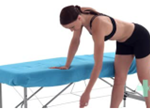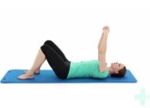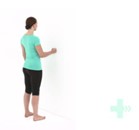Emergency Assessment Unit
Shoulder injury – soft tissue only
Patient Information Leaflet
Introduction
This leaflet is for people who have a shoulder injury. It includes information about what a shoulder injury is, how it is treated and what to do when you get home.
What is a shoulder injury?
You have been diagnosed with a soft tissue injury of your shoulder. This can involve muscles, tendons or ligaments, and can be a simple or complex injury. The clinician managing your case will explain your injury to you. Most shoulder injuries will resolve with just self-management and simple exercises in six to eight weeks.
How is it treated?
- Take pain relief, either paracetamol or ibuprofen, if you are able to (always read the label; do not exceed the recommended dose).
- Use an ice pack or bag of frozen vegetables on the area. Make sure it is wrapped in a towel and only on the area for up to 20 minutes, every few hours. Use with caution if your sensation is reduced on that side.
- Avoid things that make your shoulder worse, but try to keep the shoulder moving as able.
- To make sleep more comfortable, consider using pillows for positioning. This will ensure good neck position and support of your shoulder. When sleeping on your back, place a pillow underneath your arm. If sleeping on your side, sleep on the unaffected side and place a pillow in front of you underneath your affected arm.
Exercise
It is important to keep your shoulder moving to avoid stiffness within the joint and to maintain flexibility. The simple exercises below will help with this.
- Pendular exercises
Lean onto a table with your good arm, letting your affected arm dangle forwards in front of you. Hold some form of weight to distract from the shoulder.
Using gentle movements of the body, let this arm swing backwards, forwards, side to side, and in circles.
The more you lean your body forwards, the more you will exercise the arm.

- AAROM shoulder flexion in supine (long lever)
Lie on your back with your arms resting on your stomach.
Interlock your fingers and then use your unaffected arm to lift your affected arm towards the ceiling whilst keeping your elbows straight.
Continue this movement towards the floor behind you ensuring the weight of your affected arm is supported.
Hold this position.
Return to the start position and repeat.

- Isometric GHjt ER(N) in stand
Stand straight with the elbow on your affected arm bent to 90 degrees.
Place your other hand on the outside of your affected wrist.
Keeping your body still, push your wrist outwards into your good hand, resisting the movement.
Make sure you are trying to rotate the arm outwards, and not trying to push outwards with your elbow.
Hold this position.

- Isometric GHjt flexion (wall)
Stand up straight facing a wall.
You may want to do this exercise with your elbow bent.
Make a fist with your hand and press your fist into the wall, ensuring the movement comes from your shoulder and not your wrist or elbow.
Hold this position, with your gaze directly ahead, your neck long and your shoulder blades back and down.

Images and information taken from Physitrack®
Follow-up care
The healthcare practitioner caring for you will let you know if we need to review you. It will be in this appointment that you will be advised if any further treatment may be needed to resolve your injury.
If you need a review, we will give you an appointment which will take place in the Emergency Department, or the Fracture Clinic in the hospital.
Alternatively, we may refer you to the Virtual Fracture Clinic who will contact you. At the appointment, a senior doctor will review your injury.
If you need physiotherapy treatment, we will refer you to our Therapy Team.
If you have queries when you get home, please contact your GP or NHS 111.
Can I find out more?
You can find out more from the following weblink:
NHS Choices: http://www.nhs.uk/Conditions/shoulderpain/Pages/introduction.aspx
If you have any questions, or if there is anything you do not understand about this leaflet, please speak to one of our nurses. If you need help when you return home, please contact your GP.
If you have any feedback on this patient information leaflet, please email dgft.patient.information@nhs.net
This leaflet can be made available in large print, audio version and in other languages, please call 0800 073 0510.
Originator: Joanne Taylor Date reviewed: June 2021 Next review due: August 2026 Version: 2 DGH ref: DGH/PIL/02163
